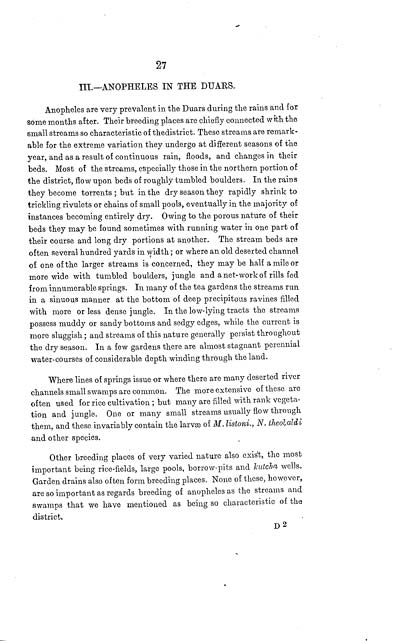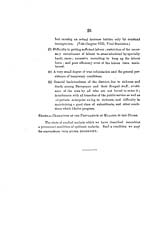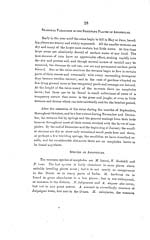Medicine - Disease > Malaria in the Duars
(35) Page 27
Download files
Individual page:
Thumbnail gallery: Grid view | List view

27
III.-ANOPHELES IN THE DUARS.
Anopheles are very prevalent in the Duars during the rains and for
some months after. Their breeding places are chiefly connected with the
small streams so characteristic of thedistrict. These streams are remark-
able for the extreme variation they undergo at different seasons of the
year, and as a result of continuous rain, floods, and changes in their
beds. Most of the streams, especially those in the northern portion of
the district, flow upon beds of roughly tumbled boulders. In the rains
they become torrents ; but in the dry season they rapidly shrink to
trickling rivulets or chains of small pools, eventually in the majority of
instances becoming entirely dry. Owing to the porous nature of their
beds they may be found sometimes with running water in one part of
their course and long dry portions at another. The stream beds are
often several hundred yards in width; or where an old deserted channel
of one of the larger streams is concerned, they may be half a mile or
more wide with tumbled boulders, jungle and a net-work of rills fed
from innumerable springs. In many of the tea gardens the streams run
in a sinuous manner at the bottom of deep precipitous ravines filled
with more or less dense jungle. In the low-lying tracts the streams
possess muddy or sandy bottoms and sedgy edges, while the current is
more sluggish; and streams of this nature generally persist throughout
the dry season. In a few gardens there are almost stagnant perennial
water-courses of considerable depth winding through the land.
Where lines of springs issue or where there are many deserted river
channels small swamps are common. The more extensive of these are
often used for rice cultivation; but many are filled with rank vegeta-
tion and jungle. One or many small streams usually flow through
them, and these invariably contain the larv of M. listoni., N. theobaldi
and other species.
Other breeding places of very varied nature also exis't, the most
important being rice-fields, large pools, borrow-pits and kutcha wells.
Garden drains also often form breeding places. None of these, however,
are so important as regards breeding of anopheles as the streams and
swamps that we have mentioned as being so characteristic of the
district.
D 2
III.-ANOPHELES IN THE DUARS.
Anopheles are very prevalent in the Duars during the rains and for
some months after. Their breeding places are chiefly connected with the
small streams so characteristic of thedistrict. These streams are remark-
able for the extreme variation they undergo at different seasons of the
year, and as a result of continuous rain, floods, and changes in their
beds. Most of the streams, especially those in the northern portion of
the district, flow upon beds of roughly tumbled boulders. In the rains
they become torrents ; but in the dry season they rapidly shrink to
trickling rivulets or chains of small pools, eventually in the majority of
instances becoming entirely dry. Owing to the porous nature of their
beds they may be found sometimes with running water in one part of
their course and long dry portions at another. The stream beds are
often several hundred yards in width; or where an old deserted channel
of one of the larger streams is concerned, they may be half a mile or
more wide with tumbled boulders, jungle and a net-work of rills fed
from innumerable springs. In many of the tea gardens the streams run
in a sinuous manner at the bottom of deep precipitous ravines filled
with more or less dense jungle. In the low-lying tracts the streams
possess muddy or sandy bottoms and sedgy edges, while the current is
more sluggish; and streams of this nature generally persist throughout
the dry season. In a few gardens there are almost stagnant perennial
water-courses of considerable depth winding through the land.
Where lines of springs issue or where there are many deserted river
channels small swamps are common. The more extensive of these are
often used for rice cultivation; but many are filled with rank vegeta-
tion and jungle. One or many small streams usually flow through
them, and these invariably contain the larv of M. listoni., N. theobaldi
and other species.
Other breeding places of very varied nature also exis't, the most
important being rice-fields, large pools, borrow-pits and kutcha wells.
Garden drains also often form breeding places. None of these, however,
are so important as regards breeding of anopheles as the streams and
swamps that we have mentioned as being so characteristic of the
district.
D 2
Set display mode to: Large image | Zoom image | Transcription
Images and transcriptions on this page, including medium image downloads, may be used under the Creative Commons Attribution 4.0 International Licence unless otherwise stated. ![]()
| India Papers > Medicine - Disease > Malaria in the Duars > (35) Page 27 |
|---|
| Permanent URL | https://digital.nls.uk/74558680 |
|---|---|
| Description | Chapter III.:Anopheles in the Duars |




